An Experimental Study of the Characteristics of Oxidation Displacement via Air Injection in a Deep, Medium–High-Pressure Reservoir
Abstract
1. Introduction
2. Physical Simulation Experiment of Air Injection Displacement
2.1. Experimental Apparatus and Procedures
- (1)
- Quartz sand with different mesh ratios was filled into the sand-packed tube and compacted. The output end of the model was connected to the vacuum pump to ensure that the vacuum degree reached below 10 Pa.
- (2)
- The injection end of the model was connected to the advection pump, and the formation water was injected at a constant speed until the output end continuously produced water, and the saturation with water was completed. At the same time, the porosity of the sand-packed tube was calculated based on the volumes of injected and produced water.
- (3)
- Initial imbibition of oil into the sands was performed. Subsequently, the advection pump was continuously utilized to displace the already saturated formation water with the crude oil until no more water was produced, and the saturation with oil was completed. The initial oil saturation was calculated based on the volume of injected and produced crude oil and produced water.
- (4)
- For the experiments of air injection after water injection, it was necessary to inject water according to the designed oil saturation and record the produced water and oil during the water injection process.
- (5)
- The backpressure data were set, and the ignition equipment was turned on. Once the ignition equipment reached 450 °C, the gas mass flow controller was opened to inject air at the ventilation intensity designed for the experiment. During the experiment, the temperature changes in the model were recorded, the volumes of produced gas and fluids were measured, the production gas components were analyzed, and the experimental results were recorded.
- (6)
- After the experiment, the experimental equipment was cleaned, and the experiments were repeated by changing the backpressure data.
2.2. Experimental Materials
- (1)
- Quartz sand: Three types of quartz sand with particle sizes of 100 mesh, 200 mesh, and greater than 1000 mesh were utilized.
- (2)
- Oil sample: Light oil samples of the Hudson reservoir in Tarim oilfield were used. Crude oil samples were first filtered with a stainless steel mesh with a pore size of 200 mesh at a temperature below 80 °C. After filtration, dehydration was performed at a temperature below 130 °C. Oil samples with water cut below 0.3% were considered qualified.
- (3)
- Gas sample: The gas used in the experiment included air and nitrogen. The impurity mass content was not higher than 0.5% air, and purity was not less than 99.9% nitrogen.
- (4)
- Water sample: The water used in the experiment had the same salinity as the formation water (252,000 mg/L), and it was CaCl2-type water.
2.3. Experimental Scheme
3. Air Injection Displacement Experiment of Different Pressure
3.1. Oxidation Displacement Characteristics of Different Pressure Experiments
3.2. Production Dynamic Characteristics of Different Pressure Experiments
4. Air Injection Displacement Experiment of Light Oil Reservoir After Water Injection
4.1. Oxidation Displacement Characteristics of Experiment After Water Injection
4.2. Production Dynamic Characteristics of Experiment After Water Injection
5. Conclusions
- (1)
- In this paper, a calculation method for air injection air consumption considering gas storage in light oil reservoirs is proposed. The air consumption of light oil is defined as the air volume consumed by the oxidation front minus the volume of stored gas in the pores sweeping through the unit volume of oil sand minus the volume of stored gas in the pores, which can more accurately reflect the oxidation state.
- (2)
- Air injection of 5 MPa, 15 MPa, and 30 MPa experiments can form a stable oxidation state and displacement state. The temperature of the oxidation front is greater than 350 °C, and the oil displacement efficiency is greater than 90%. With the increase in the pressure of the light oil air injection experiments, the oil displacement efficiency improved, resulting in less remaining oil at the oxidation front. Concurrently, the air consumption and fuel consumption of the oxidation reaction decreased, and the temperature of the oxidation front decreased accordingly.
- (3)
- When the experimental pressure is higher, the gas production–injection ratio decreases. The gas production time is late, and the production gas–oil ratio is low, minimizing the risk of gas channeling. Under 30 MPa pressure conditions, the air injection displacement process demonstrates excellent stability.
- (4)
- Compared with the air injection in the original reservoir, the air consumption and fuel consumption of the air injection after water injection experiments increase, the temperature of the experimental oxidation front becomes higher, and the oxidation front is more stable. The main reason may be the formation of water-in-oil emulsion and supercritical water during the displacement and the promotion effect on the oxidation reaction.
- (5)
- Overall, after water injection, air injection in high recovery reservoirs can form a stable oxidation state, and the temperature of the oxidation front is greater than 350 °C. The thermal oxidation front is uniformly advanced, which can significantly increase the oil production rate, reduce the water cut, and greatly improve the oil production rate. The oil displacement efficiency in the air injection stage is increased by 30 percentage points.
- (6)
- Air injection technology is expected to become a strategic development technology with potential for deep reservoirs with high permeability, high temperature, high salinity, and high water saturation.
Author Contributions
Funding
Institutional Review Board Statement
Informed Consent Statement
Data Availability Statement
Conflicts of Interest
References
- Huo, J.; Zhao, R.B.; Sun, X.G.; Yang, F.X. Progress of ISC technology and perspective on the future work of its theoretical research. Xinjiang Oil Gas 2021, 17, 30–36. [Google Scholar] [CrossRef]
- Denney, D. 30 years of successful high-pressure air injection: Performance evaluation of Buffalo field, south Dakota. J. Pet. Technol. 2011, 63, 50–53. [Google Scholar] [CrossRef]
- Cheih, C. State-of-the-Art Review of Fireflood Field Projects (includes associated papers 10901 and 10918). J. Pet. Technol. 1982, 34, 19–36. [Google Scholar] [CrossRef]
- Liao, G.; Wang, Z. High-efficiency, Low-cost and Green Air Injection Development Technology of New Generation. Pet. Sci. Technol. Forum 2020, 39, 59–66. [Google Scholar] [CrossRef]
- Barzin, Y.; Moore, R.G.; Mehta, S.A.; Ursenbach, M.G.; Tabasinejad, F. Impact of Distillation on the Combustion Kinetics of High Pressure Air Injection (HPAI); SPE Improved Oil Recovery Symposium: Tulsa, OK, USA, 2010. [Google Scholar] [CrossRef]
- Xi, C.; Wang, B.; Zhao, F.; Liu, T.; Qi, Z.; Zhang, X.; Tang, J.; Jiang, Y.; Guan, W.; Wang, H.; et al. Oxidization characteristics and thermal miscible flooding of high pressure air injection in light oil reservoirs. Pet. Explor. Dev. 2022, 49, 760–769. [Google Scholar] [CrossRef]
- Xi, C.; Wang, B.; Zhao, F.; Hua, D.; Qi, Z.; Liu, T.; Zhao, Z.; Tang, J.; Zhou, Y.; Wang, H. Miscibility of light oil and flue gas under thermal action. Pet. Explor. Dev. 2024, 51, 147–153. [Google Scholar] [CrossRef]
- Jia, H.; Yuan, C.-D.; Zhang, Y.-C.; Peng, H.; Zhong, D.; Zhao, J.-Z. Recent Progress of High Pressure Air Injection Process (HPAI) in Light Oil Reservoir: Laboratory Investigation and Field Application. In Proceedings of the SPE Heavy Oil Conference Canada, Calgary, AB, Canada, 12–14 June 2012. [Google Scholar] [CrossRef]
- Li, Y.-B.; Chen, Y.-F.; Pu, W.-F.; Peng, H.; Zhong, D.; Hu, X.-T.; Sun, B.-S. The influence factors analysis of the light crude oil oxidation reaction process. Pet. Sci. Technol. 2016, 34, 609–614. [Google Scholar] [CrossRef]
- Chen, Z.; Wang, L.; Duan, Q.; Zhang, L.; Ren, S. High-pressure air injection for improved oil recovery: Low-temperature oxidation models and thermal effect. Energy Fuels 2013, 27, 780–786. [Google Scholar] [CrossRef]
- Zhao, J.-Z.; Jia, H.; Pu, W.-F.; Wang, L.-L.; Peng, H. Sensitivity Studies on the Oxidation Behavior of Crude Oil in Porous Media. Energy Fuels 2012, 26, 6815–6823. [Google Scholar] [CrossRef]
- Li, Y.-B.; Zhao, J.-Z.; Pu, W.-F.; Peng, H.; Zhong, D.; Hu, Z.-W. A method based on the Harcourt and Esson equation to estimate the catalytic effect of metallic additives on light crude. J. Alloys Compd. 2014, 585, 7–13. [Google Scholar] [CrossRef]
- Ren, S.R.; Greaves, M.; Rathbone, R.R. Air injection LTO process: An lOR technique for light-oil reservoirs. SPE J. 2002, 7, 90–99. [Google Scholar] [CrossRef]
- Moore, R.G.; Mehta, S.A.; Ursenbach, M.G. A Guide to High Pressure Air Injection (HPAI) Based Oil Recovery. In Proceedings of the SPE/DOE Improved Oil Recovery Symposium, Tulsa, OK, USA, 13–17 April 2002. [Google Scholar] [CrossRef]
- Clara, C.; Durandeau, M.; Quenault, G.; Nguyen, T.-H. Laboratory Studies for Light-Oil Air Injection Projects: Potential Application in Handil Field. SPE Reserv. Eval. Eng. 2000, 3, 239–248. [Google Scholar] [CrossRef]
- Moore, R.G.; Mehta, S.A.; Ursenbach, M.G.; Gutierrez, D. Potential for In Situ Combustion in Depleted Conventional Oil Reservoirs. In Proceedings of the SPE Improved Oil Recovery Symposium, Tulsa, OK, USA, 14–18 April 2012. [Google Scholar] [CrossRef]
- Yuan, S.; Han, H.; Wang, H.; Luo, J.; Wang, Q.; Lei, Z.; Xi, C.; Li, J. Research progress and potential of new enhanced oil recovery methods in oilfield development. Pet. Explor. Dev. 2024, 51, 841–854. [Google Scholar] [CrossRef]
- Zhao, J.; Zhang, N.; Jiang, H.; Jiao, P. Experimental study on oxidation characteristics of heavy oil reservoirs by high-pressure in-situ combustion. Pet. Geol. Recovery Effic. 2023, 30, 145–151. [Google Scholar] [CrossRef]
- Li, Y.-B.; Chen, Y.-F.; Pu, W.-F.; Jin, F.-Y.; Yuan, C.-D.; Li, D.; Zhao, J.-Y.; Zhou, W. The Kinetic Analysis of Oxidized Oil During the High Pressure Air Injection by Thermal Kinetic Analysis. Liq. Fuels Technol. 2015, 33, 319–326. [Google Scholar] [CrossRef]
- Sun, X.; Yang, F.; Li, H.; Zhan, H.; Gao, C.; Yuan, S. Component transformation path in the process of heavy oil fire flooding based on core analysis. Spec. Oil Gas Reserv. 2024, 31, 85–90. [Google Scholar] [CrossRef]
- SY/T 6898-2012; Experimental Testing Method of In-Situ Combustion Parameters. National Energy Administration: Beijing, China, 2012.
- Xi, C.; Guan, W.; Jiang, Y.; Liang, J.; Zhou, Y.; Wu, J.; Wang, X.; Cheng, H.; Huang, J.; Wang, B. Numerical simulation of fire flooding for heavy oil reservoirs after steam injection: A case study on Block Hl of Xiniiang Oilfield, NW China. Pet. Explor. Dev. 2013, 40, 715–721. [Google Scholar] [CrossRef]
- Wang, W. Influence of different oil saturation on fire flooding. Pet. Reserv. Eval. Dev. 2021, 11, 465–468. [Google Scholar] [CrossRef]
- He, M. Study on influencing factors of physical properties of water-in-oil emulsion. China Sci. Technol. Inf. 2016, 2, 102–103. [Google Scholar] [CrossRef]
- Chen, Q.; Liu, Y.; Hou, J.; Li, X.; Wei, B.; Du, Q. Phase Transition Characteristics of Heavy Oil-Viscosity Reducer-Water Emulsion Systems. J. Mol. Liq. 2023, 379, 121638. [Google Scholar] [CrossRef]
- Shi, L.; Tang, W.; Zhou, Y.; Wang, B. Study on Water Flooding with Self⁃Emulsification in Heavy Oil Reservoirs. Xinjiang Pet. Geol. 2024, 45, 228–234. [Google Scholar] [CrossRef]
- Liang, J.; Li, F. Supercritical water-a new chemical medium. Chem. Educ. 2001, 22, 7–9. [Google Scholar]
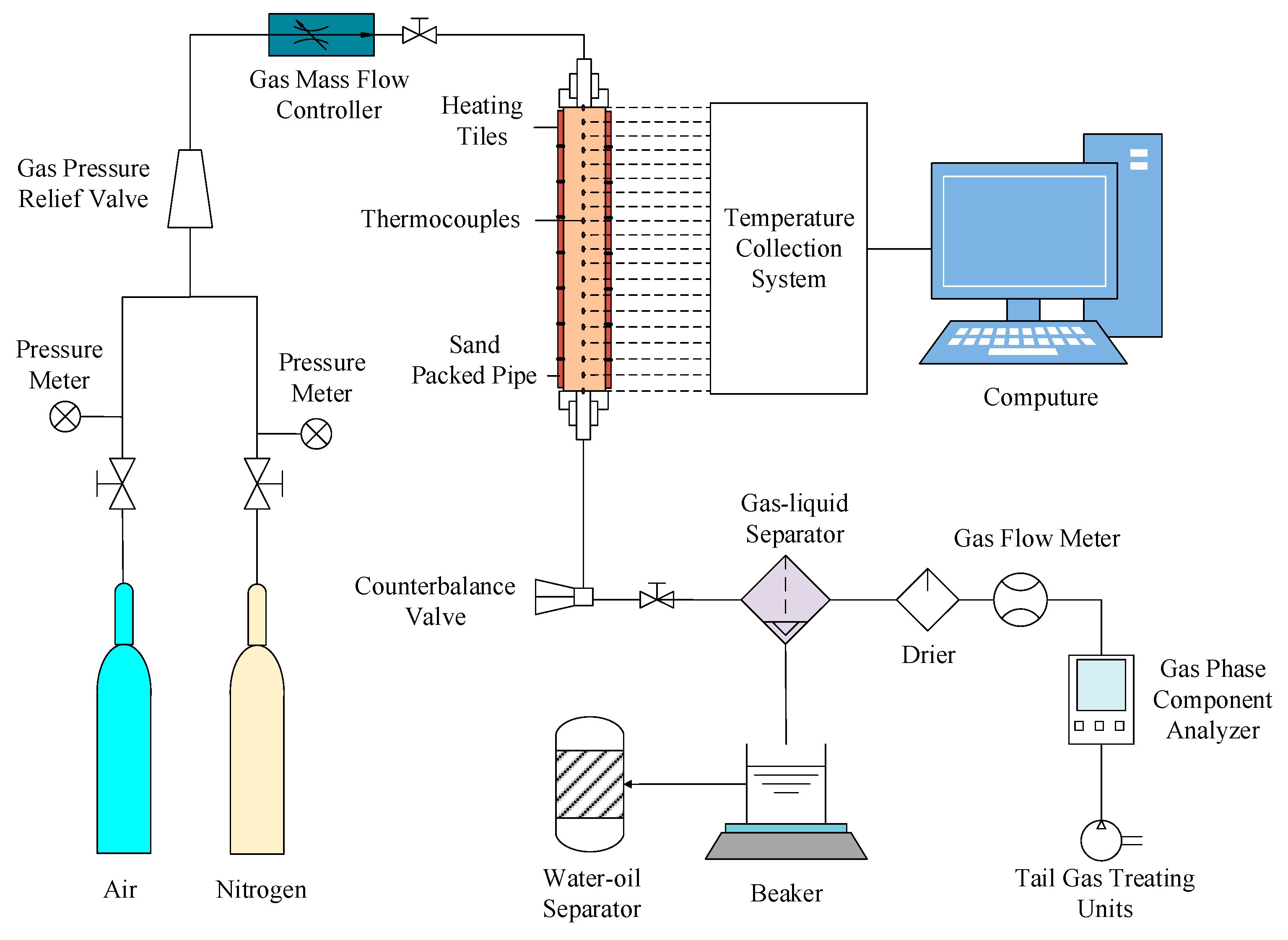


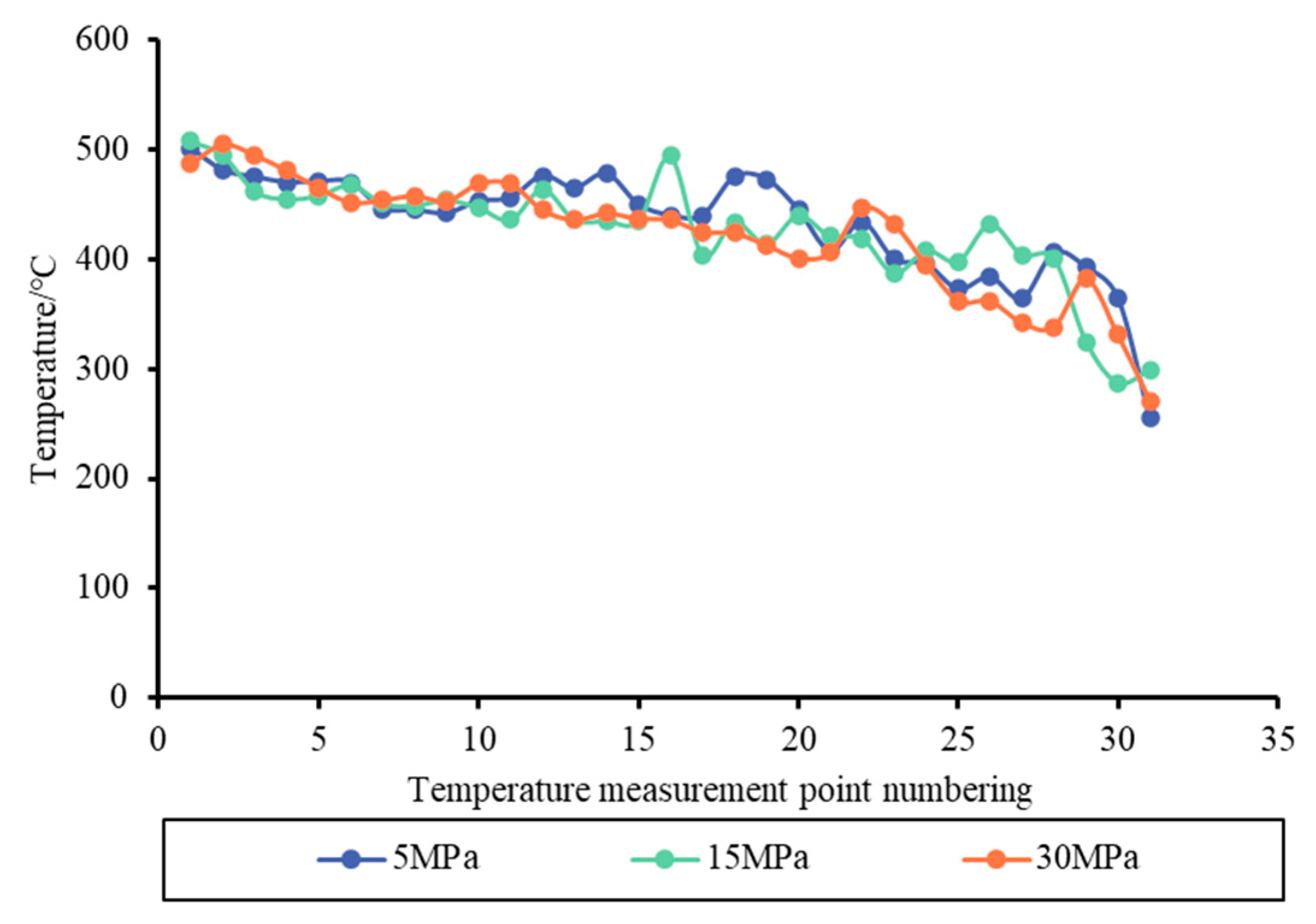

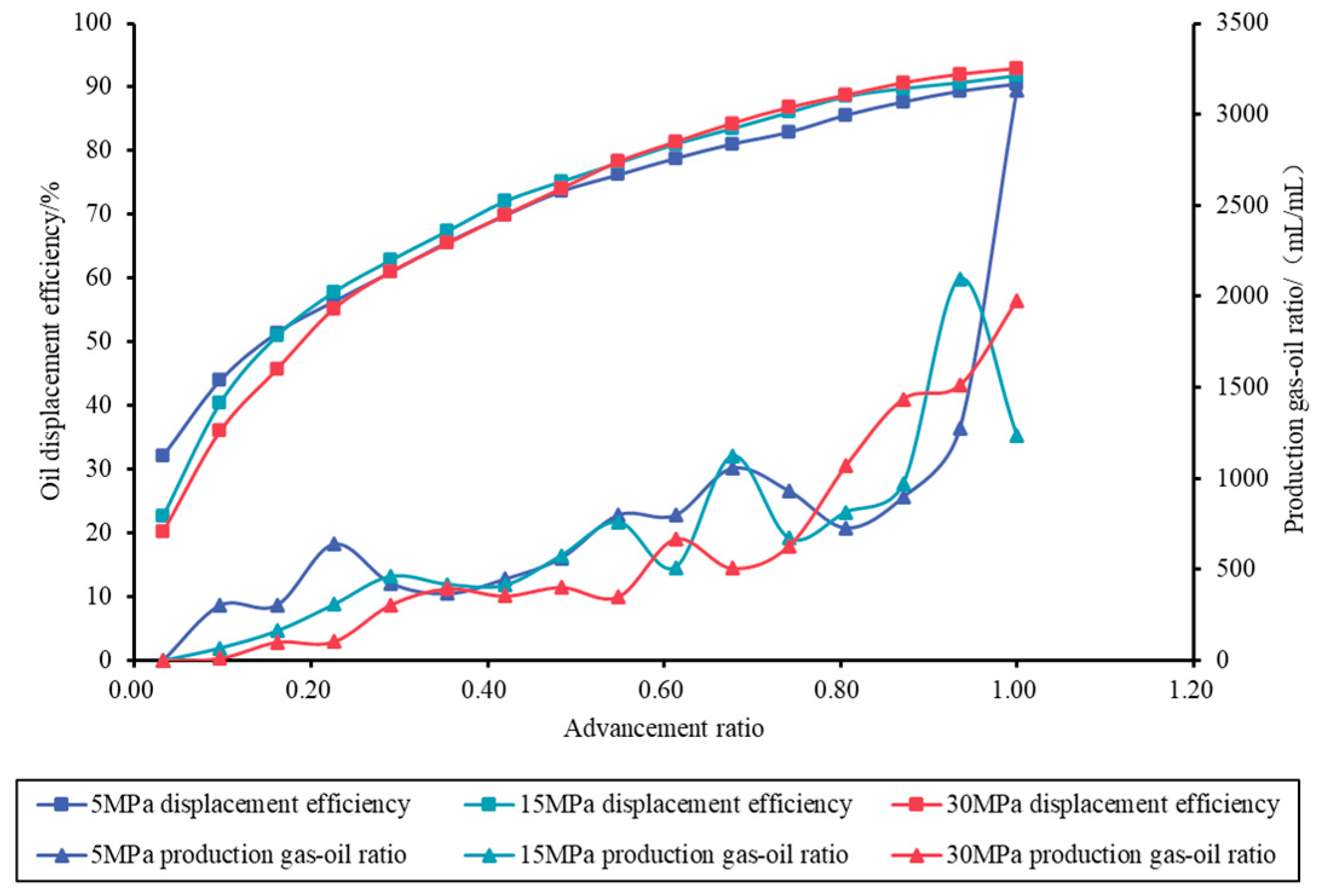
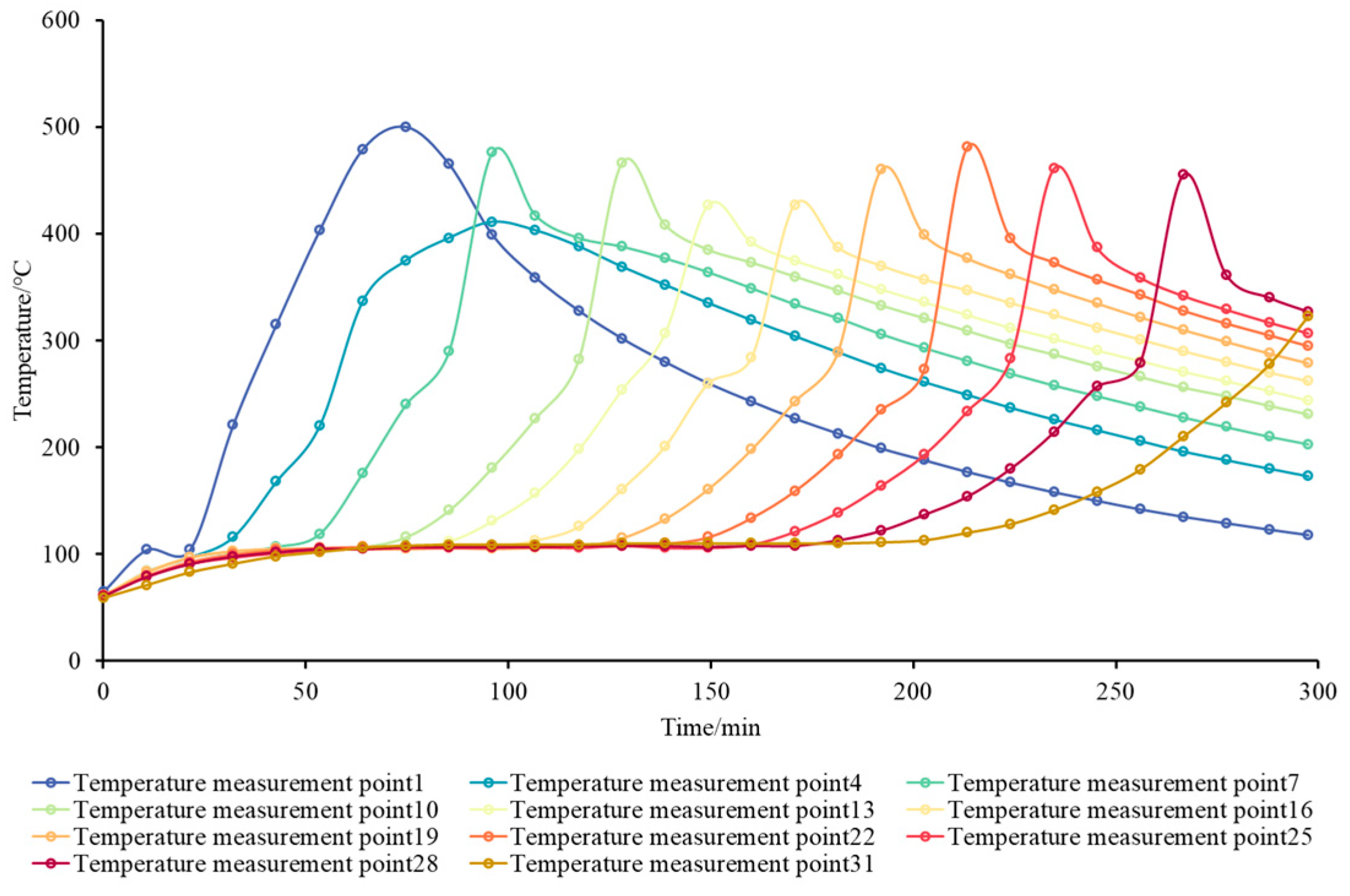
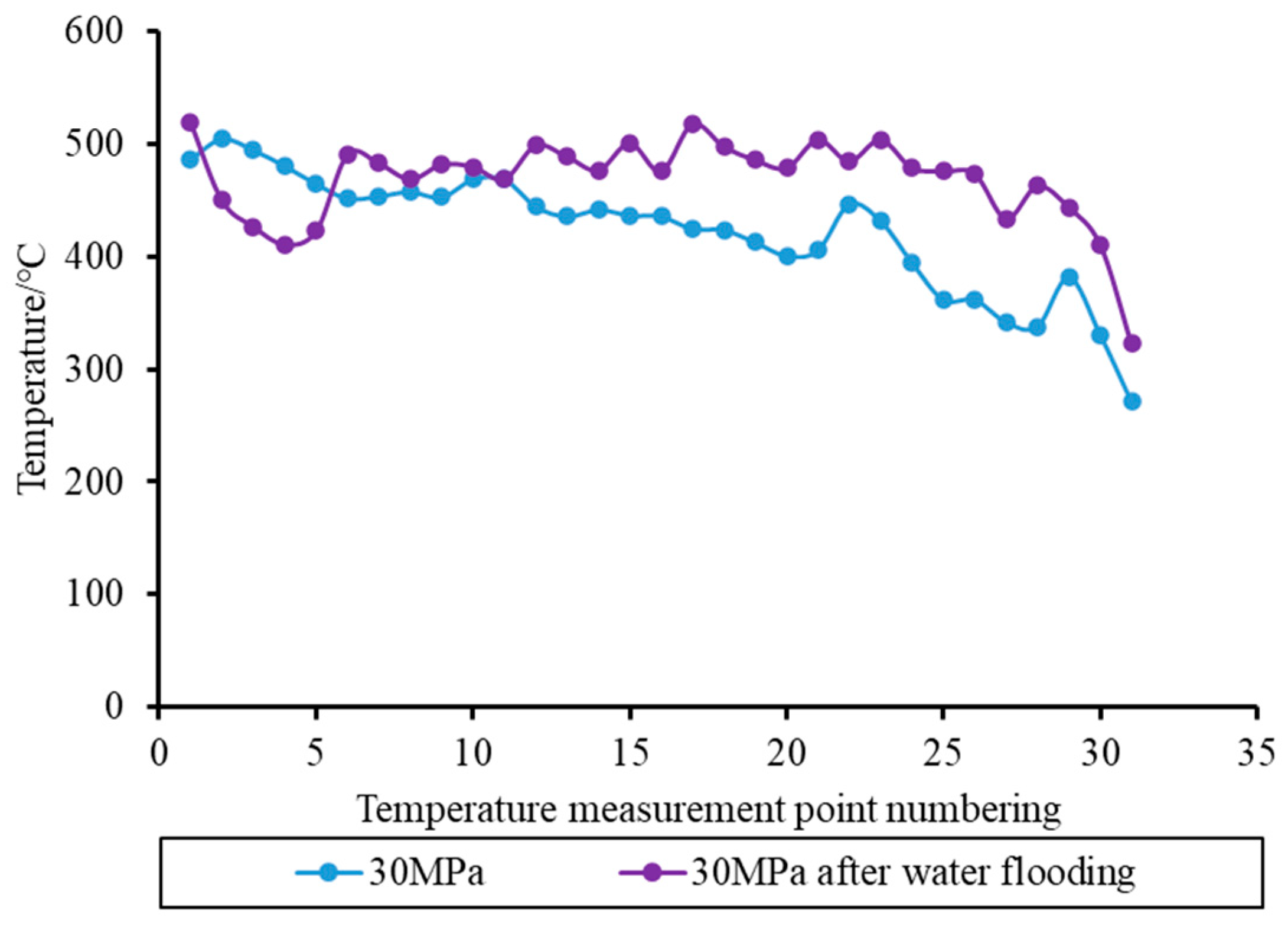
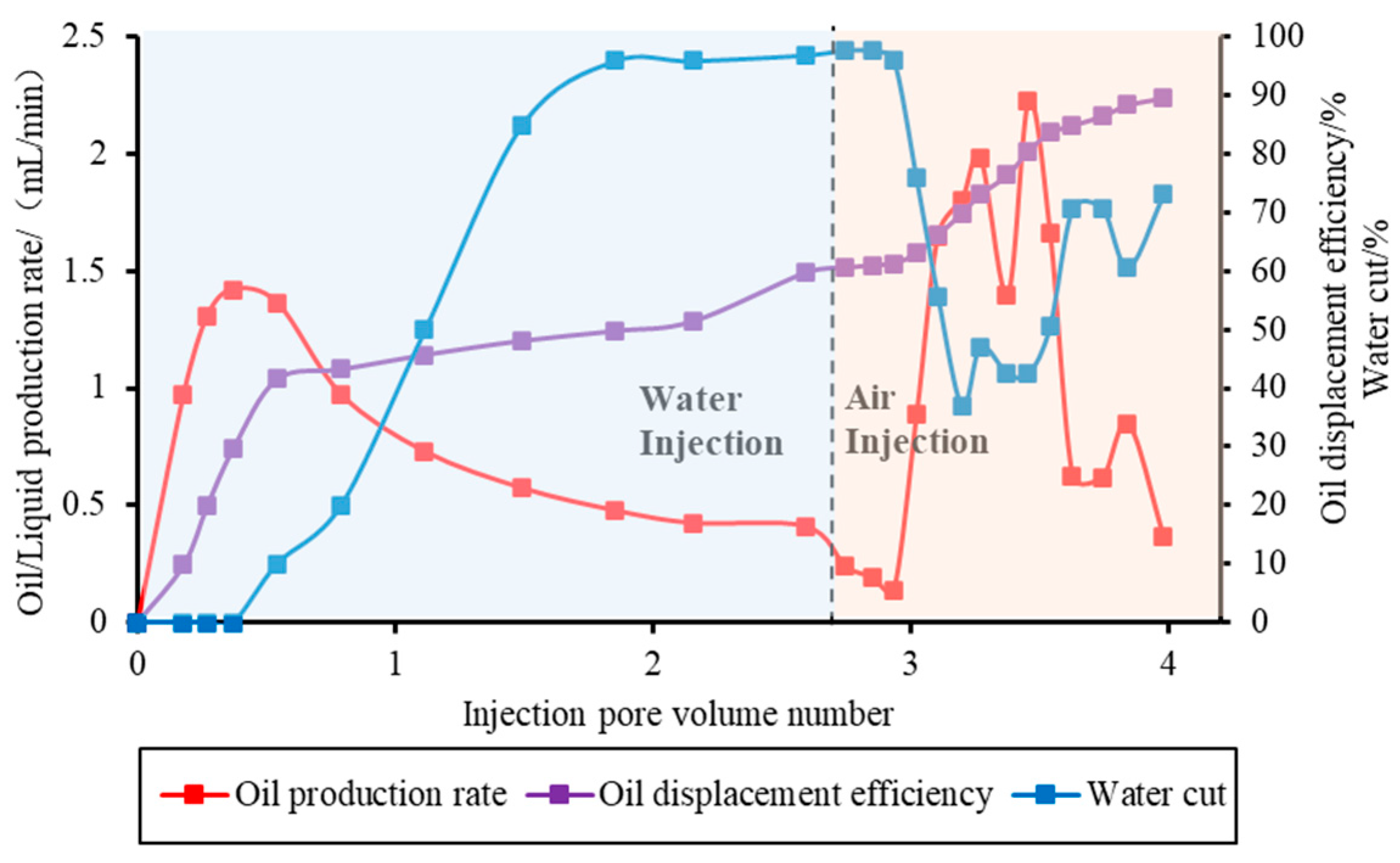
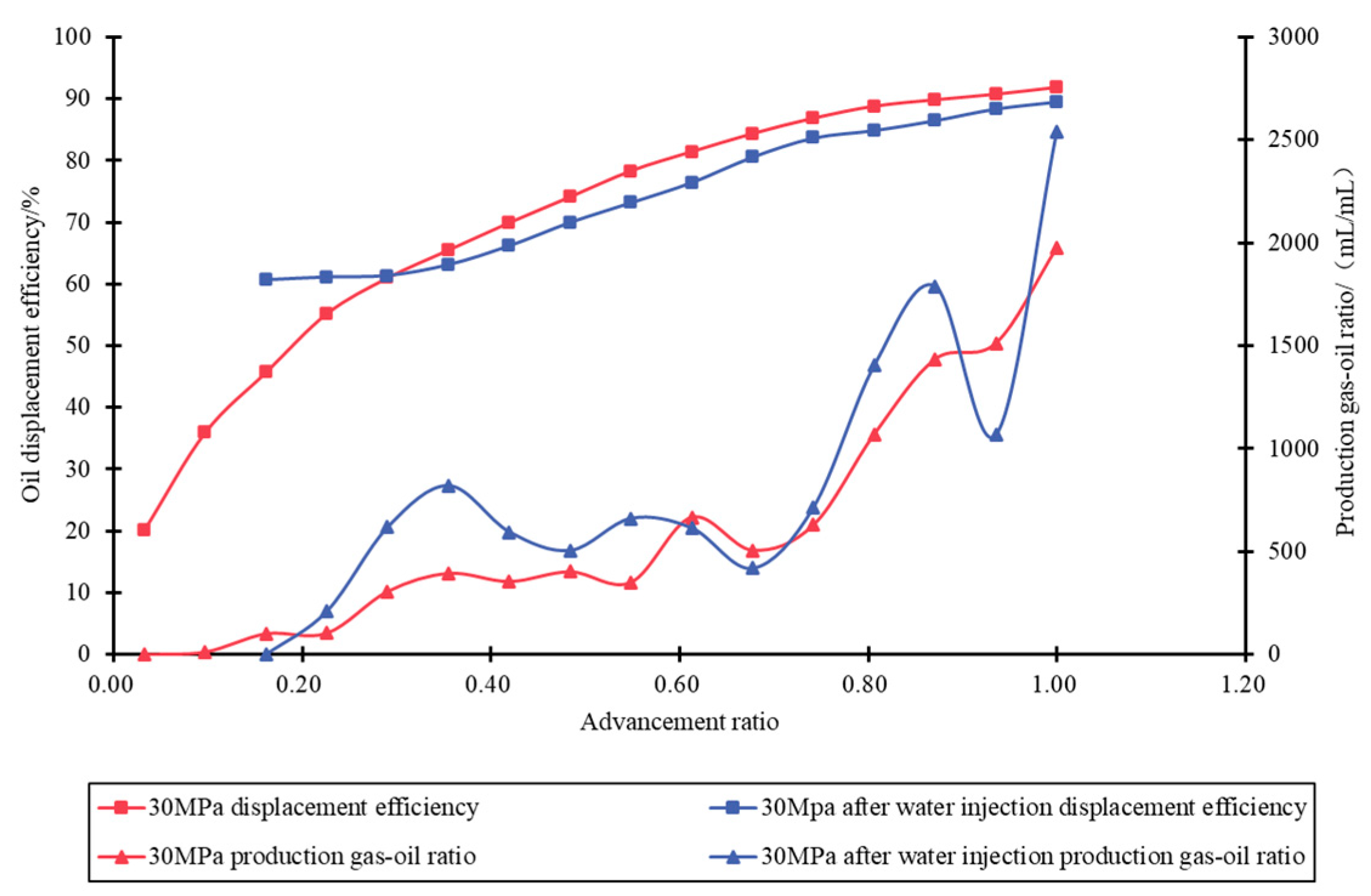
| Numbering | Experiment Type | Experimental Pressure, MPa | Experimental Temperature, °C | Experimental Condition | Ventilation Intensity, m3/(m2 h) |
|---|---|---|---|---|---|
| 1 | Hudson light oil air injection | 5 | 105 | / | 40 |
| 2 | Hudson light oil air injection | 15 | 105 | / | 40 |
| 3 | Hudson light oil air injection | 30 | 105 | / | 40 |
| 4 | Hudson light oil air injection | 30 | 105 | Water flooding | 40 |
| Numbering | Experimental Pressure, MPa | Average Oxygen Content (%) | Average Carbon Dioxide Content (%) | Average Methane Content (%) |
|---|---|---|---|---|
| 1 | 5 | 3.29 | 11.26 | 4.91 |
| 2 | 15 | 2.64 | 12.72 | 4.31 |
| 3 | 30 | 1.81 | 12.64 | 4.05 |
| Numbering | Experimental Pressure, MPa | Air Injection Volume, L | Gas Production, L | Gas Storage Volume, L | Air Consumption, m3/m3 | Fuel Consumption, kg/m3 | Air Consumption (Considering Gas Storage), m3/m3 |
|---|---|---|---|---|---|---|---|
| 1 | 5 | 302.78 | 277 | 25.78 | 118.46 | 9.93 | 106.69 |
| 2 | 15 | 313.58 | 239 | 74.58 | 129.49 | 9.81 | 92.50 |
| 3 | 30 | 333.21 | 188 | 145.21 | 144.78 | 9.31 | 76.81 |
| Numbering | Experimental Pressure, MPa | Oil Saturation, % | Saturated Oil Volume, mL | Total Liquid Production, mL | Total Oil Production, mL | Total Gas Production, L | Gas Production–Injection Ratio |
|---|---|---|---|---|---|---|---|
| 1 | 5 | 85.45 | 805.00 | 848.61 | 728.54 | 277 | 0.91 |
| 2 | 15 | 84.65 | 818.43 | 955.09 | 760.61 | 239 | 0.76 |
| 3 | 30 | 84.59 | 830.00 | 945.75 | 761.94 | 188 | 0.56 |
| Numbering | Experimental Pressure, MPa | Average Oxygen Content (%) | Average Carbon Dioxide Content (%) | Average Methane Content (%) |
|---|---|---|---|---|
| 3 | 30 | 1.81 | 12.64 | 4.05 |
| 4 | 30 | 2.03 | 12.49 | 4.71 |
| Numbering | Experimental pressure, MPa | Experimental Condition | Air Injection Volume, L | Gas Production, L | Gas Storage Volume, L | Fuel Consumption, kg/m3 | Air Consumption (Considering Gas Storage), m3/m3 |
|---|---|---|---|---|---|---|---|
| 3 | 30 | / | 333.21 | 188 | 145.21 | 9.31 | 76.81 |
| 4 | 30 | Water injection | 350.42 | 200 | 150.42 | 9.74 | 91.34 |
Disclaimer/Publisher’s Note: The statements, opinions and data contained in all publications are solely those of the individual author(s) and contributor(s) and not of MDPI and/or the editor(s). MDPI and/or the editor(s) disclaim responsibility for any injury to people or property resulting from any ideas, methods, instructions or products referred to in the content. |
© 2025 by the authors. Licensee MDPI, Basel, Switzerland. This article is an open access article distributed under the terms and conditions of the Creative Commons Attribution (CC BY) license (https://creativecommons.org/licenses/by/4.0/).
Share and Cite
Zhao, Z.; Xi, C.; Wang, B.; Liu, P.; Zhao, F.; Qi, Z.; Liu, T.; Hua, D.; Zhang, X. An Experimental Study of the Characteristics of Oxidation Displacement via Air Injection in a Deep, Medium–High-Pressure Reservoir. Appl. Sci. 2025, 15, 3301. https://doi.org/10.3390/app15063301
Zhao Z, Xi C, Wang B, Liu P, Zhao F, Qi Z, Liu T, Hua D, Zhang X. An Experimental Study of the Characteristics of Oxidation Displacement via Air Injection in a Deep, Medium–High-Pressure Reservoir. Applied Sciences. 2025; 15(6):3301. https://doi.org/10.3390/app15063301
Chicago/Turabian StyleZhao, Zeqi, Changfeng Xi, Bojun Wang, Peng Liu, Fang Zhao, Zongyao Qi, Tong Liu, Daode Hua, and Xiaokun Zhang. 2025. "An Experimental Study of the Characteristics of Oxidation Displacement via Air Injection in a Deep, Medium–High-Pressure Reservoir" Applied Sciences 15, no. 6: 3301. https://doi.org/10.3390/app15063301
APA StyleZhao, Z., Xi, C., Wang, B., Liu, P., Zhao, F., Qi, Z., Liu, T., Hua, D., & Zhang, X. (2025). An Experimental Study of the Characteristics of Oxidation Displacement via Air Injection in a Deep, Medium–High-Pressure Reservoir. Applied Sciences, 15(6), 3301. https://doi.org/10.3390/app15063301





